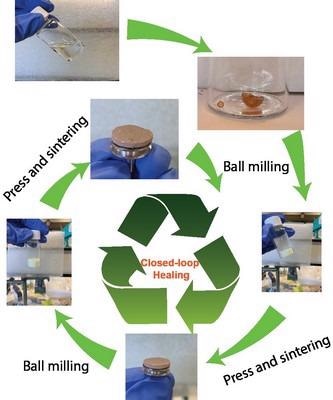Mar 10 2021
Polymer researchers from the University of Groningen and the NHL Stenden University of Applied Sciences, both located in the Netherlands, have designed a new polymer membrane from biobased malic acid.
 The new vitrimer membrane is made by pressing and sintering polymers from the natural monomer malic acid. This membrane can be recycled by ball milling and subsequent pressing and sintering. Image Credit: Chongnan Ye, University of Groningen.
The new vitrimer membrane is made by pressing and sintering polymers from the natural monomer malic acid. This membrane can be recycled by ball milling and subsequent pressing and sintering. Image Credit: Chongnan Ye, University of Groningen.
The polymer membrane is a superamphiphilic vitrimer epoxy resin membrane that can be utilized to separate oil from water and is completely recyclable.
When foulants block the pores, the latter can be cleaned, depolymerized, and later pressed into a new membrane.
A study explaining the development of this membrane was published in the Advanced Materials journal on March 7th, 2021.
It can be quite difficult to clean up an oil spill in water. Superamphiphilic membranes, which 'love' both water and oil, offer a potential solution, but these membranes are not practical as such.
Often, such membranes are not strong enough to be used beyond laboratory settings and the membrane pores could clog up because of fouling by sand and algae.
Chongnan Ye and Katja Loos from the University of Groningen and Vincent Voet and Rudy Folkersma from NHL Stenden have now utilized a comparatively new type of polymer to produce a membrane that is robust and can be easily recycled.
Dynamic Network
In the recent past, the team from both institutes has collaborated to examine vitrimer plastics— polymer materials that have the chemical resistance and mechanical properties of a thermoset plastic.
But vitrimer plastics can also work similar to a thermoplastic, as they can be depolymerized and used again. This suggests that a vitrimer plastic has all the features to serve as an excellent membrane for oil spill remediation.
Furthermore, it was made from malic acid, a natural monomer.
Dr Katja Loos, Professor, University of Groningen
“The polymers in the vitrimer are crosslinked in a reversible manner. They form a dynamic network, which enables recycling of the membrane,” explained Voet.
The vitrimer is created via base-catalyzed ring-opening polymerization between epoxy-modified and pristine biobased malic acid.
Through ball milling, the polymers are ground into a powder and then converted into a porous membrane via the sintering process.
Pores
Both oil and water will get scattered on the resulting superamphiphilic membrane. In an oil spill, relatively more water is present than oil, meaning that the membrane is enclosed by water that can subsequently pass via the pores.
The water film on the membrane’s surface keeps the oil out of the pores, so that it is separated from the water.
Vincent Voet, NHL Stenden
The membrane is sufficiently hard to extract oil from the water. When the pores are clogged up by algae and sand, the membrane could be depolymerized and reproduced from the building blocks after removing the pollutants.
We have tested this on a laboratory scale of a few square centimetres. And we are confident that our methods are scalable, both for the polymer synthesis and for the production and recycling of the membrane.
Dr Katja Loos, Professor,, University of Groningen
The researchers believe that an industrial partner will take up the additional development.
Applications
Designing this novel membrane for oil spill remediation demonstrates the power of collaboration between an applied university and a research university.
“A while ago, we decided that the polymer groups at the two institutes should become one, by sharing students, staff and facilities. We recently started the first hybrid research group in the Netherlands,” added Loos.
This makes it simpler to discover applications for newly developed materials.
“Polymer chemists strive to link molecular structures to material properties and applications. Our hybrid research team has the experience to do just that,” Voet concluded.
Journal Reference:
Ye, C., et al. (2021) Robust Superamphiphilic Membrane with a Closed‐Loop Life Cycle. Advanced Materials. doi.org/10.1002/adma.202008460.